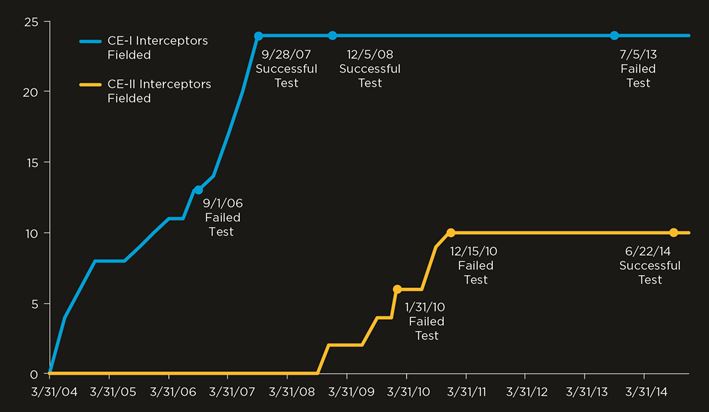The upcoming missile defense test will also be the first intercept test of a new kill vehicle and will use an upgraded booster for the interceptor.
The Ground-Based Midcourse (GMD) system currently has 36 deployed interceptors. A majority of the interceptors use a type of kill vehicle, the CE-I variant, that has had only two successful intercept tests in four tries. Its last successful intercept test was in 2008; the most recent test failed.
The other interceptors are equipped with the CE-II kill vehicle, which has had only a single successful intercept test in three tries. The Director of Operational Test and Evaluation’s 2014 report stated: “The reliability of the interceptors is low, and the [Missile Defense Agency (MDA)] continues discovering new failure modes during testing.”
The upcoming test will be the first intercept test of the new CE-II Block 1 kill vehicle. It uses newly designed divert thrusters meant to fix persistent problems guiding the kill vehicle. The divert thrusters are the small motors that make course adjustments when the kill vehicle is homing on its target. They make the fine adjustments in direction that make the difference between a hit and a miss.
The kill vehicle is the heart of the homeland missile defense system. Yet it has been dogged by a persistent problem called the track gate anomaly, which has appeared in tests for more than a decade, and which led to a failed intercept in 2010. The Missile Defense Agency has tried software and hardware fixes, essentially to compensate for vibrations caused by the rough combustion of the small divert motors. The CE-II Block 1 kill vehicle uses a new set of those motors to try to solve this problem. It was flight tested in January 2016, without complete success. In that case, one of the four motors stopped working and the kill vehicle flew off course—way off course.
The improved interceptor booster has upgraded avionics, and addresses obsolescence and reliability issues.
What if the test fails?
The Missile Defense Agency has been committed to increasing the number of interceptors to 44 before the end of 2017. To do so, it will be emplacing 10 new interceptors with CE-II Block 1 kill vehicles on them (eight CE-II Block 1 interceptors to complete the fleet and two to replace older interceptors equipped with the CE-I kill vehicle.) The Agency Director stated in testimony that he is waiting for the (presumably) successful intercept test before delivering these.
While that may seem an obvious criterion, that’s not the way GMD business has been done in the past. All (or nearly all) other currently-fielded GBI were fielded before they had completed a successful intercept test, as is shown in Fig. 1.

Fig. 1. This shows the number of deployed interceptors with the CE-I and CE-II kill vehicles (vertical axis) and the tests of those kill vehicles. (Source: “Shielded from Oversight”)
So, should this test fail, a consequence may be that the interceptor fielding would be put on hold until the test was repeated successfully. Because GMD tests take a significant amount of time to plan and organize, this is unlikely to happen quickly. For example, the January FTG-06 2010 intercept test failed and was repeated in December of that year.
Will political pressure to field these interceptors win out even if the test fails?
What if it’s a success?
Even if the test is successful, it is very important to look holistically at the capabilities of the system and what has actually been demonstrated. While this test may demonstrate that the Missile Defense Agency is on the right track with the fixes to the kill vehicle, overall it is not even close to demonstrating that the system works in a real-world setting. The system has not yet been tested in the range of conditions under which it is expected to operate—for example, it hasn’t been successfully tested at night or against complex countermeasures that a determined adversary would surely try to include. The Pentagon’s Director for Operational Test and Evaluation assessment in 2014 is that the tests to date are “insufficient to demonstrate that an operationally useful defense capability exists.”
A successful test this week is the basis for better understanding the capabilities of the system, but it is not the basis for expanding the system. Whether this week’s test is successful or not, the GMD system is still far from being able to provide reliable protection from a real-world missile threat.
Part 1 of this post can be found here.
